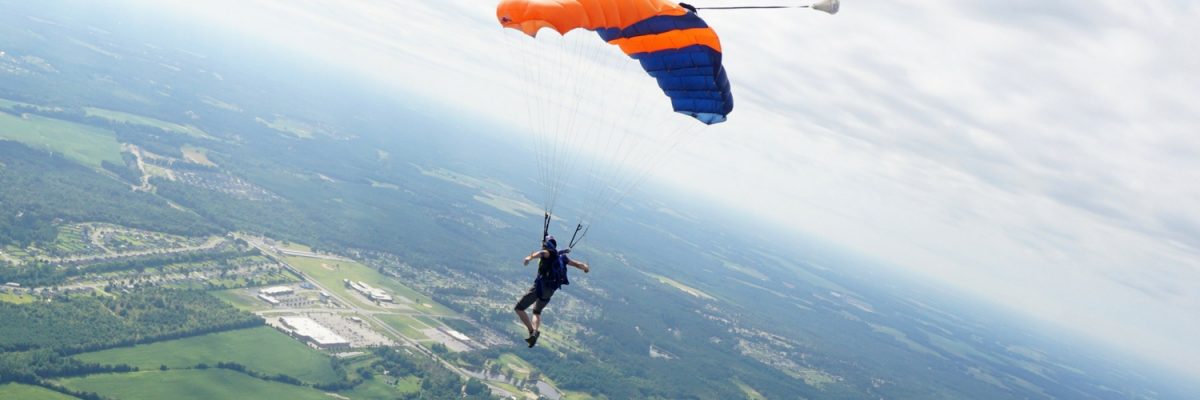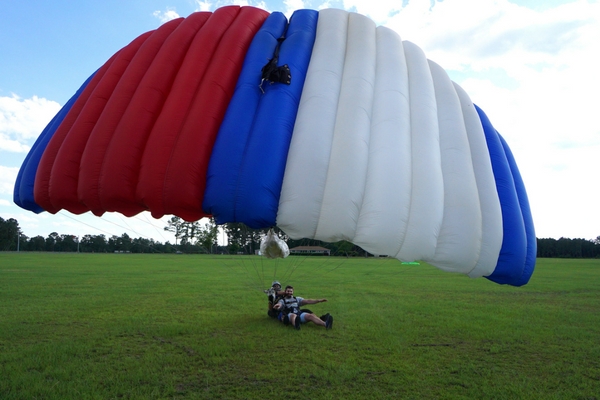
The Proper Way To Steer A Parachute
Tuesday, May 26, 2020
- Team FlyXP
- 5/26/20
- 0
- General, Skydiving, Skydiving Training
In skydiving, two parts make a whole. The sport’s not just composed of a swift freefall reaching speeds of 120 miles per hour. Part of the fun of any skydive is the canopy flight. With modern day parachutes, the options for your flight are downright customizable. The ability to maneuver a man-made wing, increasing speed for a zippy ride or casually soaring about like a bird on a breeze, is what makes modern skydiving so enchanting. But this wasn’t always the case. Parachute steering has come a long way.
Parachute Steering in the Past
There was little to no parachute steering capacity in the early iterations of skydiving canopies. The parachutes used at civilian skydiving’s inception were generally surplus equipment from the military. They were dome-shaped and solely a means for increasing drag to safely deliver men and cargo to designated places.
Round parachutes offered jumpers a consistent and docile opening, rarely malfunctioned, and could tolerate handling from less-experienced skydivers. But they lacked one crucial thing: maneuverability.
How would you steer a round parachute? Well, you wouldn’t. Round parachutes could only be “steered” by pivoting around the center point of the canopy. If you were the canopy pilot in control of a round parachute, you could choose which way you would face, slightly affecting the direction of flight but not much else. Round parachutes do not generate lift, and thus had a very slight glide ratio.
Parachute Steering Today
Parachutes today are marvels of modern engineering. And would you guess that there are companies all over the globe vying to create the next, best parachute?
Just like car models, the reliable minivan, the speedster Porsche or the practical sedan, there are many different types of parachutes. Though, despite the different applications for these parachutes, a few things remain the same.
Parachutes today are RAM-air. Two layers of material are sectioned into elongated cells. The cells are open at the front of the parachute and are sealed at the back. As the parachute moves forward, air is forced into the cells, which then stiffens the “wing” and gives it shape. Much like an airplane wing, the air moves faster over the parachute than under it, which generates lift.

How do you steer a parachute?
A series of lines descend from the parachute down to the pilot. Along the back edge of the parachute, you will find the steering lines. These lines cascade down about half of the length of the line, four converging to become one on each side and ending where your hands can reach into a reinforced loop — what we call a steering toggle.
These are how you steer the parachute. When you pull down on the right steering toggle only, the back side on the right of the parachute cups to create drag, turning the canopy right. The same applies to the left steering toggle. If you pull down on the left steering toggle only, the back side of the left parachute cups to create drag and induces a left turn.
Additionally, risers, webbing that connect a parachute container to the lines, are another way to steer parachutes. There are four risers, two front risers and two rear risers. Your toggles and steering lines are attached to the rear risers. This means you can use the rear risers to make turns as well, and in exactly the same manner as the toggles. You pull down on the right rear riser to turn right and on the left rear riser to turn left.
In addition to steering the parachute, the toggles have another important function: flaring (slowing or stopping the forward and downward momentum of the parachute). If you want to flare a parachute, pull down evenly on both toggles at the same time. The halfway point converts downward momentum to forward momentum, and when both arms are fully extended the back of the parachute cups down and stops the forward momentum as well.
Parachute Steering at Skydive Paraclete XP
If you join us for a tandem skydive and the conditions are right, you can try your own hand at parachute steering! Just ask your tandem skydiving instructor for the opportunity to hold on to the toggles and steer. They’ll be there to guide you and take back over when it’s time to come in for the landing.
Copyright © 2025, Skydive Paraclete XP, All Rights Reserved.
DropZone Web Design & Marketing by Beyond Marketing, LLC
